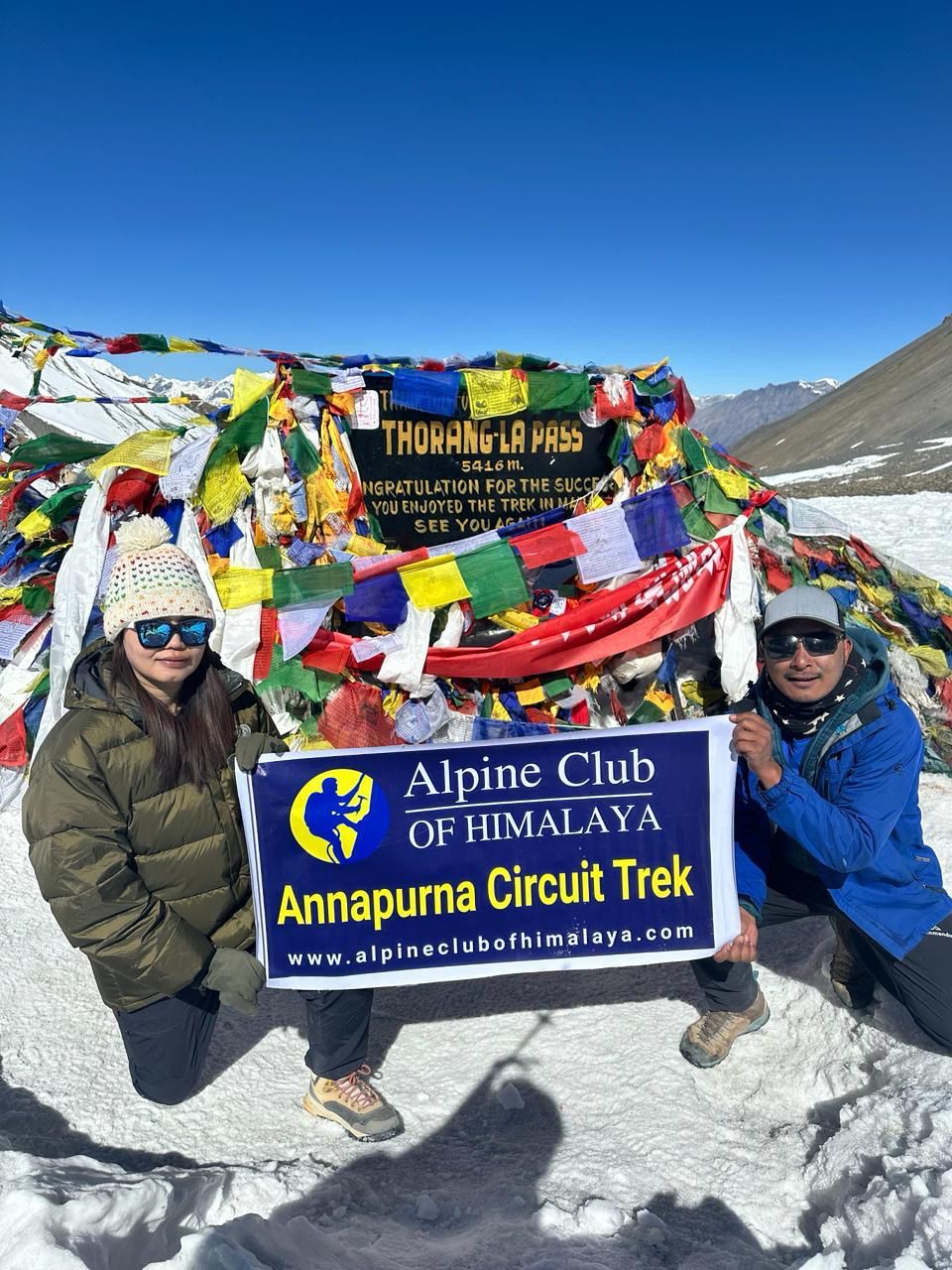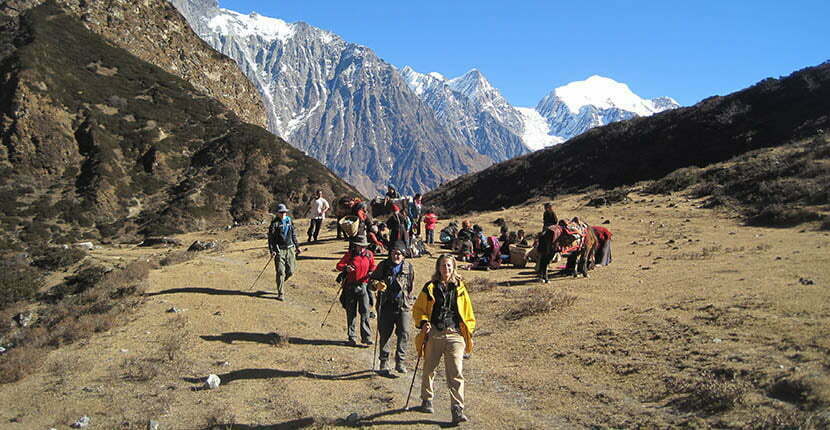The Ama Dablam expedition – Ama Dablam also known as Amai Dablang is one of the world’s most picturous peaks. Nestled in the laps of the Mahalangur sub-range of the Greater Himalaya. Tucked in the southeastern part of the country. A region where the mighty Himalayas, pristine glaciers, and towering cliffs surround the landscape. Mt. Ama Dablam lies in the renowned Khumbu region tugged between the mighty Mt. Everest and Mt.Lhotse the first and fourth highest peaks of the planet.
Ama Dablam translated as “Ama” mother, Dablam “necklace” is Mother Nature’s sparkler gem. The main peak stands at an elevation of 6,812 meters/ 22,349 feet, and the lower western peak at 6,170 meters/ 20,243 feet. The main peak is often referred to as the Matterhorn of the Himalayas for its symmetrical pyramid shape. The peak was first scaled on 13 March 1961 by Mike Gill (NZ), Barry Bishop (USA), Mike Ward (UK), and Wally Romanes (NZ) via the Southwest Ridge. Since then, it is the third most popular Himalayan peak permitted for the expedition.
The ascent to the peak is usually via the southwestern ridge. Where two camps were established along the ridge and the third camp below the hanging glacier of the Ama Dablam pictorious peak. The climb is challenging having sections of sheer cliffs, ice sheets, snow, and glaciers. So a high level of physical and mental fitness with prior climbing experience is required.
The adventure begins with a scenic flight from Kathmandu to Lukla. From Lukla, you will begin the trek traversing across various settlements and deep sections of wilderness. Crossing the villages of Phakding, Namche Bazaar eventually reached Thyangboche. Then commencing a ritual ceremony for a safe pass to the summit head towards Ama Dablam Base Camp. After various activities and training at the base camp head on the climb. The climb takes you to Camp I, II, III, and finally to the summit of the peak. After scaling the peak head back towards the camps and back to Namche Bazaar and eventually to Kathmandu.
The Ama Dablam expedition is an exciting and thrilling journey that is not to be missed by any avid mountaineer or climbing enthusiast. Join in with us at the Alpine Club of Himalaya and head on an exciting and thrilling journey of Ama Dablam.
You might like: Ama Dablam Expedition: See Beautiful Peak Valleys Of Nepal
Entry fee and Permits:
The following permits are required Ama Dablam Expedition:
- Mountaineering Fees: Spring Season 400, Autumn Season 400, Winter/Summer 200 (USD)
- Sagarmatha National Park Entry Permit and
- Khumbu Rural Municipality Entrance Permit.
The Nepal Tourism Boards’ office in Kathmandu or the park’s entrance gate in Monjo can provide you with Sagarmatha National Park Entry Permit for NRS 3000.
The fee for citizens of SAARC nations is NRS 1500.
You must complete the permit application and present your passport or a copy of your passport. You must be in Lukla to obtain the Khumbu Pasang Lhamu Rural Municipality Entrance Permit. The permission costs NRS 2000 and may be acquired at the rural municipality counter on the outskirts of the settlement.
You won’t have to worry about waiting for permits since the Alpine Club of Himalaya or our guides will take care of everything.
Accommodation:
You will be accommodated in 3-star hotels in Kathmandu. During the trek, we will be staying at lodges/ teahouses providing basic facilities. From the base camp, you will be staying in makeshift camps.
Meals and drinking water:
Everest region Trek is one of the most facilitated trekking destinations in the country, providing basic to luxury ones.
In this trial, you’ll be provided with a variety of cuisine to choose from. Nepali, Tibetan, Indian, and western as well as continental meals. As the region has small tea houses to luxury hotels the facilities they provide are basic to grandeur according to your budget. Try various traditional cuisine and popular snacks and delicacies renowned in the region.
Similarly, drinking water is accessible with natural water supplies which are untreated, so direct use of the water is not recommended, you may refill boiling water or cold filter water from any of the teahouses. However, if you buy a water purification tablet, chlorine drops, or utilize SODIS (sunlight assisted) filtration procedures for further assurance, saving money, and reducing plastic pollution.
Best Time to Visit for The Ama Dablam expedition
The best season for trekking in the Everest region during the season of autumn and spring, the months of September, October, November, March, April, and May.
During the autumn season, the months of September, October, and November the weather is clear with warm temperatures and the visibility is great. As the weather is mild it’s very easy to get around the region.
The spring season of March, April, and May is also the best time to visit the Everest region, marking the end of the winter, the spring season brings a change in the topography of the region and the destination comes to life with endless rows of different colored rhododendron, moss and orchid draped trees, colorful undergrowth stretching for miles and the snowy white mountains peaks on the backdrop of clear blue skies.
Monsoon season is not favorable for trekking as the weather gets harsh and it’s hard to get around the country with frequent landslides and floods. So usually, monsoon season is avoided by trekkers.
In the winter season, the area receives a high amount of snowfall, covering most of the trail, and access is denied to most of the regions of Everest, making it impossible to trek.
Travel Insurance:
All clients participating in any activity must have travel insurance. Personal injury, death, hospital expenditures, repatriation fees, and helicopter rescue. Any other disease covered by the insurance plan will be given. We highly advise you to acquire a comprehensive insurance plan from a trustworthy insurance company.
Passport and Visa:
Every client must have a valid passport from the return date with a 6-month prior validity by the Nepalese consulate in your country or the immigration office at Tribhuvan International Airport in Kathmandu.
Equipment lists:
General Equipment required for The Ama Dablam expedition:
- Find the guidelines regarding essential trekking gear.
- Daypack above 40 liters. (Must be waterproof)
- Down jacket (rental available)
- Warm sleeping bag (rental available)
- Sun head, gulf cap, sunglasses, headlamp, and torchlight.
- Ear-muffs, wooly Hat, Fleece Balaclava
- Sun Lotions/sun cream.
- One pair of liner gloves is thin wool and synthetic.
- Cotton t-shirts, Synthetic t-shirts.
- Thermal Top, Fleece Sallopettes, Thin Fleece
- Body Warmer – Thick Fleece -Schoeller Trousers
- Long-sleeve polyester or synthetic lightweight for sunny days.
- One Soft-shell jacket (water & wind resist)
- Inner clothes as your requirement.
- Liner socks, woolen socks.
- Proper trekking shoes, Sandals
- Imodium or Pepto Bismo capsules for upset stomach or diarrhea.
- Diamox for altitude sickness. The guide will help you to take it.
- One small personal-sized first-aid kit with blister treatments such as moleskin, bands,
- anti-infection ointments, and muscle relief ointments
- Wet wipes
- Vitamin Tablets
Technical Equipment required:
- Ice Axe, Ice Hammer
- Harness, Crampons, Ice Screws
- Belay Plate, Jumar and Ropeman, Prussicks
- Rack – Tat + Maillons – Abalokov Threader
- Head Torch x 2 – Spare Batteries + bulb – Rope
- Helmet – Radio + Batteries – Spare Pick
- Repair Kit (tape, superglue, string, cable ties, strap, needle, thread, leatherman with pliers)
Important note:
Your safety is of paramount importance to us at the Alpine Club of Himalaya. We have the absolute authority to cancel the trip or change the itinerary, when deemed necessary or when we have reason to believe your safety is at stake. Weather conditions, the health condition of a group member, natural disasters, and such, can contribute to changes in the itinerary when traveling in remote mountainous regions. In these extreme situations, we kindly request that you offer your full cooperation to the trusted leader of the group appointed by the Alpine Club of Himalaya. However, we assure you that we will make every effort to keep to the above itinerary.
Ama Dablam Expedition:
The climb takes you trekking across various landscapes for 9 days to the base camp. From the base camp, the climb is physically and mentally demanding. Prior experience is required from here, we recommended skilled and experienced climbers only. The climbing period lasts from day 10 to the 26. Taking you across the astonishing beauty of the Khumbu region.
Climb Highlights:
- Ascend the picturous Ama Dablam.
- Traverse across various landscapes and microclimates.
- Explore isolated villages.
- Visit ancient monasteries of the region.
- Learn about the rich culture and traditions of the indigenous people.
- Witness views like never before views of the greater Himalayan range.
- Thrilling and adrenaline rush Adventure.

















Write a Review